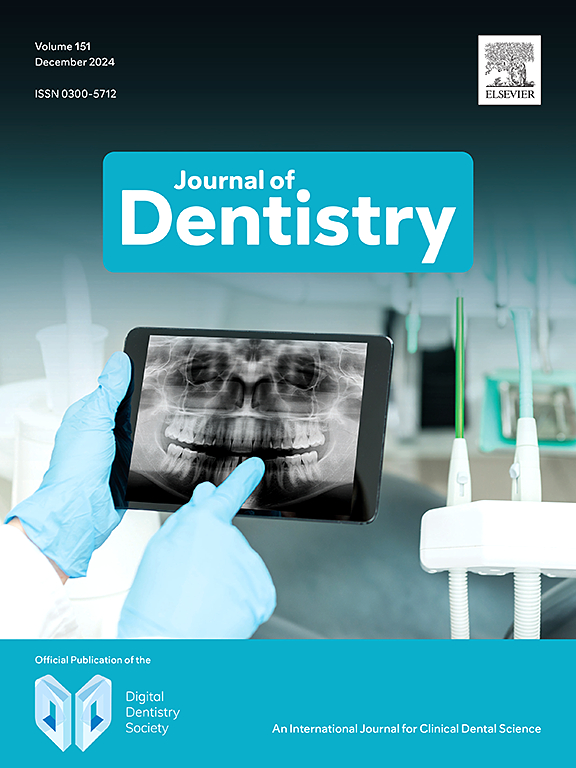Effect of whitening pens on hydrogen peroxide permeability in the pulp chamber, color change and surface morphology
IF 4.8
2区 医学
Q1 DENTISTRY, ORAL SURGERY & MEDICINE
引用次数: 0
Abstract
Objective
To evaluate hydrogen peroxide (HP) permeability into the pulp chamber, color change, and surface morphology promoted by different whitening pens.
Material and methods
Fifty premolars were divided into five groups (n = 10): untreated control; Colgate Optic White Express Whitening Pen (OE-C), Colgate Optic White Overnight Whitening Pen (OW-C), Equate Teeth Whitening Kit (TK-E) and Zimba Teeth Whitening Pen (TW-Z), applied daily for 15 minutes over ten days. HP permeability (μg/mL) was measured using UV–VIS spectroscopy, and color change (ΔEab, ΔE00, and WID) by a digital spectrophotometer at baseline (T0), after one (T1), five (T5) and ten days (T10). Initial HP concentration (%), pH and surface morphology were determined through titration, pH meter, and scanning electron microscopy, respectively. Statistical analysis included one-way and two-way ANOVA with Tukey's and Dunnett's tests (α = 0.05).
Results
OE-C and OW-C exhibited higher pH, lower HP concentrations, reduced HP penetration (p < 0.05), and a similar surface morphology pattern compared to TK-E and TW-Z. Bleaching efficacy showed no significant differences among the whitening pens (p > 0.05). For ΔEab and ΔE00, OE-C and OW-C showed similar color changes across all time points, whereas the TK-E and TW-Z exhibited greater changes from T0 to T5 and T0 to T10 (p < 0.05). WID values significantly increased at T5 and T10 across all groups (p < 0.05).
Conclusions
Whitening pens vary in pH, initial hydrogen peroxide concentration, and hydrogen peroxide penetration; however, these differences do not significantly impact their surface morphology and bleaching effect.
Clinical significance
The use of whitening pens appears promising for achieving effective teeth bleaching after five days of application. However, the detection of hydrogen peroxide within the pulp chamber may increase the risk of tooth sensitivity.
求助全文
约1分钟内获得全文
求助全文
来源期刊

Journal of dentistry
医学-牙科与口腔外科
CiteScore
7.30
自引率
11.40%
发文量
349
审稿时长
35 days
期刊介绍:
The Journal of Dentistry has an open access mirror journal The Journal of Dentistry: X, sharing the same aims and scope, editorial team, submission system and rigorous peer review.
The Journal of Dentistry is the leading international dental journal within the field of Restorative Dentistry. Placing an emphasis on publishing novel and high-quality research papers, the Journal aims to influence the practice of dentistry at clinician, research, industry and policy-maker level on an international basis.
Topics covered include the management of dental disease, periodontology, endodontology, operative dentistry, fixed and removable prosthodontics, dental biomaterials science, long-term clinical trials including epidemiology and oral health, technology transfer of new scientific instrumentation or procedures, as well as clinically relevant oral biology and translational research.
The Journal of Dentistry will publish original scientific research papers including short communications. It is also interested in publishing review articles and leaders in themed areas which will be linked to new scientific research. Conference proceedings are also welcome and expressions of interest should be communicated to the Editor.
 求助内容:
求助内容: 应助结果提醒方式:
应助结果提醒方式:


